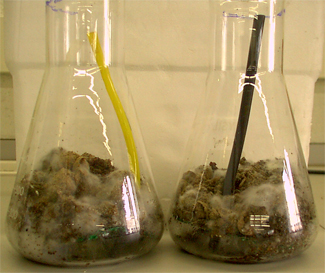New microorganisms in the composting process

Today, solid waste treatment is a global problem when considering sustainable development, given the pollution associated to this kind of wastes, and the increasing generation. This problem poses an important challenge to modern societies.In this framework, technologies of recycling and biological treatment have a low environmental burden and they are an alternative recommended by European administration for the waste treatment and management. Among these technologies, composting is especially relevant in Catalonia, as can be seen in the large number of plants recently constructed. Nevertheless, composting is usually applied to the treatment of wastes of municipal origin, whereas studies with industrial wastes are scarce.
In the research presented, composting process is studied for two organic complementary wastes due to their chemical composition. On one hand, wastewater sludge coming from the treatment of industrial wastewater, a highly biodegradable waste with a high nitrogen content. On the other hand, fat produced in the food industry, which presents a low biodegradability, they are insoluble in water and poor in nitrogen content. Both wastes are problematic in their treatment and the traditional management option has been landfill or incineration. Mixtures of both wastes have been carried out at lab scale using different ratios of fat (ranging from 10 to 80%) in order to find an optimal ratio (Imatge 1- A wastewater sludge and fat mix).
In all the experiments conducted, composting followed a typical behavior, although it was concluded that the fat proportion should not be over 40%. Nevertheless, in all cases it was observed the development of microorganisms capable of waste biodegradation, especially filamentous fungi. (Imatge 2-A Fungus picture). The last point of this research consisted of trying to identify enzymes responsible of fat biodegradation, known generally as lipases. Active microorganisms could not been identified from isolated predominant enzymes, which demonstrated that further efforts are necessary in this environmental research field.
References
Gea, T; Ferrer, P; Alvaro, G; Valero, F; Artola, A; Sanchez, A. "Co-composting of sewage sludge : fats mixtures and characteristics of the lipases involved". BIOCHEMICAL ENGINEERING JOURNAL, 33 (3): 275-283 MAR 2007.

